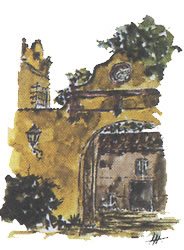Cerebro-facio-thoracic dysplasia – TMCO1 gene
Cerebro-facio-thoracic dysplasia, also known as Pascual-Castroviejo type 1 syndrome or TMCO1 defect syndrome, is a disorder characterized by abnormal development of the brain, facial structures and torso. The key features of the disease include severe intellectual disability, distinctive facial features and abnormalities of the ribs and vertebrae.
In addition to intellectual disability, the signs related to this process may include delay or absence in the development of motor skills and language; behavioral problems; hypotonia; distinctive facial features such as brachycephaly, synophritis, hypertelorism, a wide nasal bridge, lower implant ears, upper lip with pronounced Cupid's bow, microdontia and, in some cases, gingival hyperplasia and cleft palate or cleft lip. In addition, problems in bone development in the chest generally result in bone abnormalities, such as fused ribs, bifid ribs, scoliosis, fused vertebrae and involvement of the shoulder blades.
Other less frequent signs include abnormalities that affect the eyes, skin or hair; heart defects; digestive problems; genitourinary problems (such as kidneys or abnormal reproductive organs); and abnormalities in the bones or joints in other parts of the body.
This process is due to mutations in the TMCO1 gene (transmembrane and coiled-coil domains 1), located on the long arm of chromosome 1 (1q24.1), which encodes a protein that forms channels through which the calcium ions flow. The TMCO1 protein helps regulate the balance of calcium ions inside the endoplasmic reticulum. Calcium acts as a signal for many cellular functions, including growth, cell division and genetic activity. The proper balance of these ions in cells and cell compartments is important for the development and function of various tissues and organs.
At least, four mutations in the TMCO1 gene have been identified that give rise to the development of cerebral-facio-thoracic dysplasia. The mutations described result in the synthesis of abnormally short TMCO1 proteins, which are likely to break down rapidly. Without this protein, TMCO1 channels cannot form and excess calcium accumulates in the endoplasmic reticulum. The calcium imbalance in this compartment disrupts the development of a variety of tissues and organs, such as the brain and structures of the head, face and torso, which gives rise to the characteristics of the disease.
This disease is inherited with an autosomal recessive pattern, which means that both copies of the gene in each cell must have mutations for the alteration to be expressed. The parents of an individual with an autosomal recessive disease have a copy of the mutated gene, but usually do not show signs and symptoms of the disease.
Tests performed in IVAMI: in IVAMI we perform the detection of mutations associated with the cerebro-facio-thoracic dysplasia, by means of the complete PCR amplification of the exons of the TMCO1 gene, and their subsequent sequencing.
Recommended samples: non-coagulated blood obtained with EDTA for separation of blood leucocytes, or a card with a dried blood sample (IVAMI can mail the card to deposit the blood sample).



